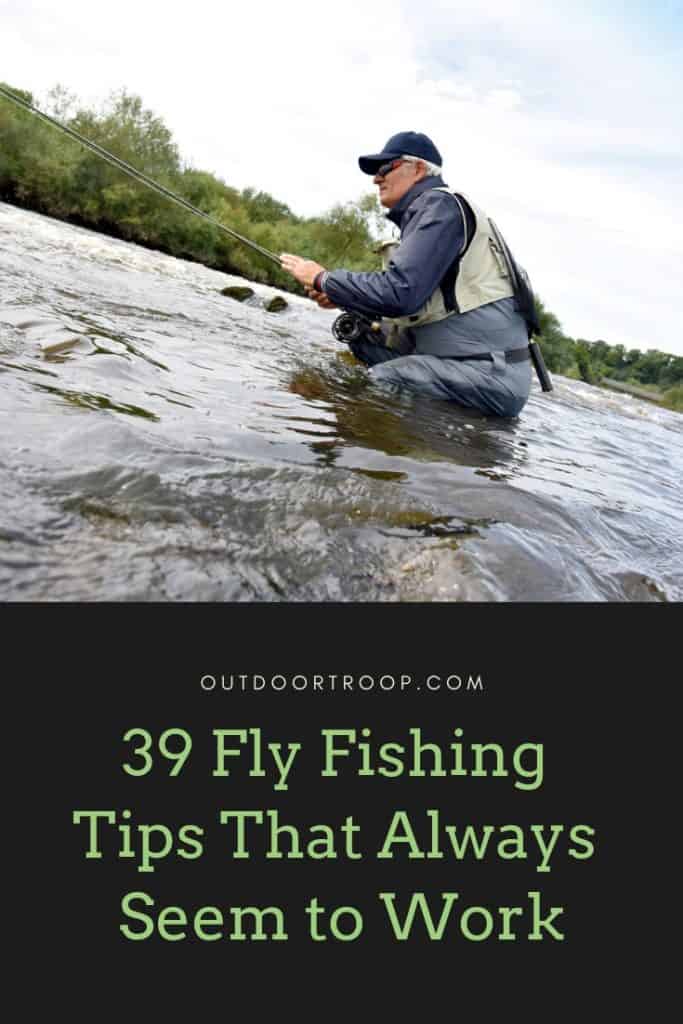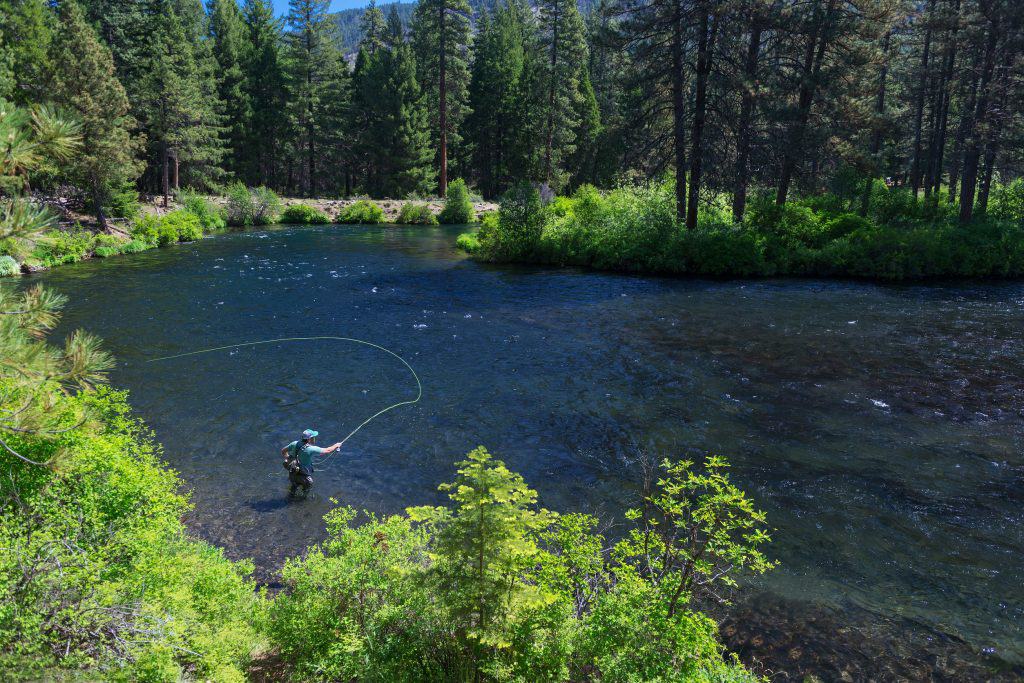
Learning how to fly fish? Need some tips that are sure to help you reel in that big fish? I gathered a list of 39 fly fishing tips that can help you do that.
If you want to learn how to be the next best fly master, be sure to take a look at all the tips I have for you, and then put each of them into action! Practice is what truly makes us perfect.
Now read on to see the fly fishing tips you have been looking for your entire life!
The Tips You’ve Been Searching For
If you’ve been searching through fly fishing websites, books, and magazines claiming to hold the key to unlocking the secrets of fly fishing. Well, I can now tell you, you have finally found it.
Below are the pieces to the puzzle that you have been missing. With luck and lots of practice, they can help you truly unlock that master fly fisherman inside of you!
#1 Use All Types of Flies
One of the wonders of fly fishing is that it allows you to reach the fish in a new way that fishing with a baited hook or lure do not allow you to do.
Take advantage of this and use many different types of flies so you can see which method the fish prefer. Always remember though, that no two types of fish are alike, so knowing how to catch them using the different flies is actually a necessary skill.
Don’t be afraid to switch up your fly multiple times in the same fishing trip!
#2 Fish in New Places
While many fishermen know that super “secret” spot that took them days, weeks, months, or even years to find, it is alright to explore other stretches of
Not only does exploring a new stretch of water allow you to see new views rather than that same old tree or bush, but it might just help you find patterns and certain spots in the river where the trout like to gather.
Remember even if you do happen to find another jackpot location, keep moving! Don’t get bogged down by fishing in the same hole every time.
#3 Return to Humble Beginnings
Now that you have explored a little, do not forget to return to the familiar fishing holes. (Confusing right?)
The point of returning to the familiar fishing spots is to know a bit more about the fish and how they will react to your line. However, since you know a little bit about them, they also know a little bit about you. Don’t worry too much though! The fish are not keeping tabs on you.
Since there is a mutual understanding in these familiar waters, there is more of a competition between you and the fish. It no longer is a game of chance but a battle of the wits.
So take the challenge and return to those places where you may have struggled or even scored big before!
#4 Get Organized
Nothing is worse than knowing exactly what lure you want to use, and then not be able to find it in your pack.
As well as organizing your gear, organize your system of fishing. What I mean by that is that you should make every cast count. Do not waste time out on the water making mindless mistakes. Be thoughtful in every decision you make.
One of the main skills needed for fly fishing is being able to think strategically. Be actively thinking and considering what you should do next.
#5 Set Daily Goals
If you are hoping to catch lots of fish, focus on catching lots of fish! But if you are hoping to catch one big one, focus on that!
There is a saying that if you chase two rabbits, both will get away. If you are trying to catch as many fish in hopes that one of them will be the big one you have been dreaming of, chances are you will not have a very successful fishing trip.
So, set a goal before you even hit the water! “Today I am going to hit my bag count” or “Today is the day I finally reel in the big one.”
Focus on using your acquired skills to achieve that goal and do not fret if it doesn’t quite work out the way you were hoping.
#6 Reel in Catches Quickly
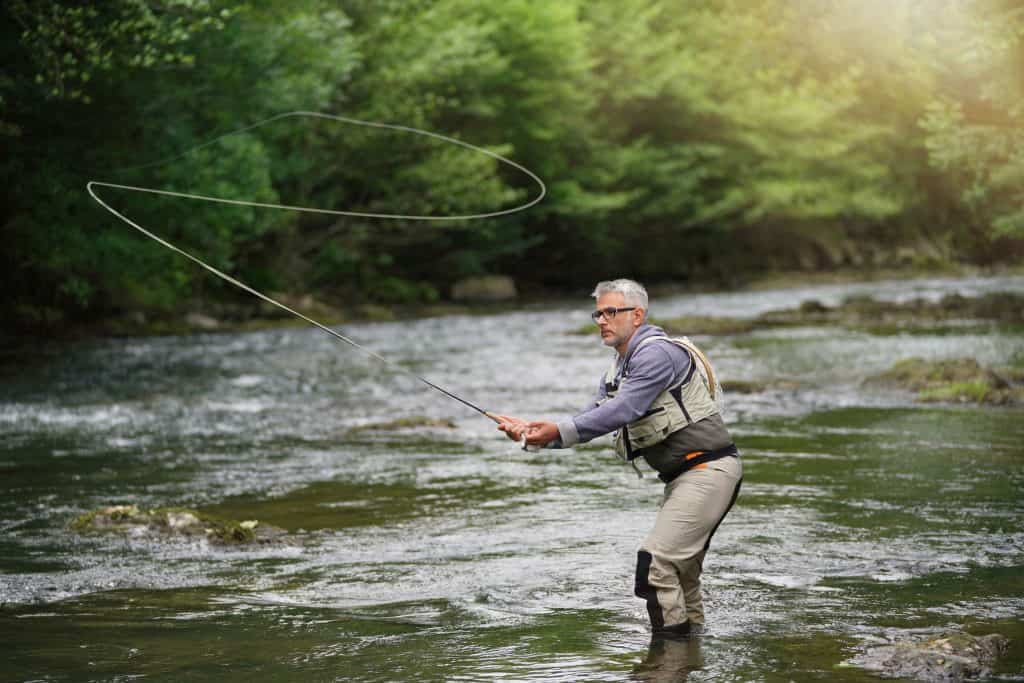
Letting a fish tug at the end is not good for your (or the fish’s) health.
The fish has a greater chance of injuring itself the longer you allow it to pull and fight back against your line. Reeling it in fast and ending the fight is honestly the safest way for the fish.
Well, what do I mean it isn’t good for your health? Let me pose this story for you. You finally have that big fish on the end of your line, your dreams are about to come true and all you have to do is successfully reel the fish in.
However, you let the fight go on too long and suddenly, the line snaps! Needless to say, that kind of heartbreak just isn’t good for your health.
But seriously, end the fight quickly! The easiest way to do this is to get the right positioning between you and the fish.
Being downstream from the fish is the best place for you to be. If possible, move downstream with the fish and try to let it swim right into you as you are reeling in.
#7 Count Your Casts
No, I am not saying that you should mark a tally down every time you cast your line out; however, I am saying that you should make sure every line casts.
Earlier I talked about how it was important to think strategically, and strategy applies to more than just fishing location and the
If you are one of those fishermen that enjoy “drawing” shapes in the air or water with your line, do yourself a favor and break the habit.
Your cast should be focused on how you want the line to react in the water for the fish, not what designs you can create to impress that lady fishing nearby.
So count your casts and make sure you are not mending your line too much in the water (especially for fun).
#8 Tie Your Own Flies
We all have some of those generic store-bought flies that we just cannot bring ourselves to let go of. Plus, learning how to tie your own fly may seem like it’s too hard and not worth the time it takes.
If you’re an avid fly fisher though, tying your own flies can be a great way to customize your fishing experience. The most important thing about tying your own fly is that YOU get to say how they look.
You are the only one who has seen quite how the fish react to your previous casts and flies. You are the one who sees the local bug and the
So take a look at your surroundings, do the research, learn the skill, and start tying your own flies. Odds are you will have another fun pass time and you will be reeling in bigger and better fish.
#9 Don’t Get Too Specific
You shouldn’t feel pressured to use the super fancy specialized fly rod when you’re out on the river all day. In fact, most of those rods are specifically designed to help you only in very specific circumstances.
If you are going to be fishing using only one tactic, make sure that you use a rod that is more specifically designed to get the job done in that area.
However, if you are planning on switching your tactics and trying many different things while out in the water, use the generalized rod.
You should never be embarrassed to use a trusty general fly fishing rod. You are fishing for you (and the fish) not for those who may be watching from nearby.
#10 Fish with Friends

It can get a little lonely on the water if you are by yourself. While you may think that
Try inviting a more experienced friend to join you, and share your tips and insights
When picking a fishing partner, make sure that the person you choose is willing to put in the same amount of work as you, that they are going to help provide and enhance a fun fishing atmosphere, and that they are not going to create unwanted competition.
#11 Use Tippet Rings
Using a tippet ring, while a small change, can make a big difference in your fishing trip.
Tippet rings can make leader and tippet changes faster, and they even use less material.
The best tip I have for using a tippet ring is to attach them with a snap swivel of a safety pin. While you can purchase tippet rings already attached to the swivel of the pin, there are also tippet rings sold individually.
Some say the extra time put in to attach the tippet ring simply isn’t worth the rewards, but I think that every little bit helps when you’re dealing with finicky fish.
Putting in more time to catch that big fish just makes the achievement more rewarding in the end.
#12 Learn to Do it Yourself
If you have ever cast out and thought, “Wow, I wish I had a leader that could (insert task)” and haven’t been able to find that dream leader in the fly shop, you’ll understand why tying your own leaders can benefit you greatly.
As I said with the flies, you are the only one who knows your current fishing situation. While using all the premanufactured pieces is quick, easy, and just seems more desirable, putting in the time to ensure your fishing trip is perfectly customized to you is worth the time put in.
How could having customized fishing gear not be worth the time put in to make it yourself?
#13 Big Flies Do Not Equal Big Fish

The simple fact of the matter is, the trophy fish you are dreaming of catching most likely isn’t going to go for the larger flies.
The best fly for catching a trophy trout is either with a medium or small fly.
If you are wondering what qualifies as a “small” fly, this is largely left open to interpretation. However, it is safe to say that most streamers are too big to fit into the “small” fly category.
Remember though, the fly does not determine whether or not you will catch a fish. It really is all in the cast and your ability to use a drift to your advantage.
#14 Choose Your Water Carefully
If you are setting out to learn something about how the fish react in that area, choose one area of the water and focus your trip there.
However, if you are hoping to fill your bag limit, then choose an area of the water that is sure to be a fish feeding grounds.
It is important to be aware of where in the water you are casting and what kind of water you are casting into.
Going along with that, don’t cast into an area that you know isn’t going to be holding any fish. You can’t will the fish onto your line, you have to help them a little by casting where they will actuall be.
#15 Don’t Fear the Snags
We all know the pain of snagging our line on a submerged log or rock. While it can be extremely frustrating, do not let it be your worst fear!
Take chances out on the river! Playing it safe doesn’t always equal the joy of taking a
If you snag your line, take pride in it the fact that you were brave enough to take the chance another might not have taken!
#16 Search for the Feeding Fish
While most river trout won’t react the same way as a large school of fish in the ocean huddling together, they do seem to act in a similar way to each other.
If you find one feeing trout, casting in the same area is likely to help you reel in another, and another… and another… and so on.
Finding the feeding fish may be your ticket to filling your bag limit for the day!
#17 Confidence is Key
Over time you will be able to find confidence in your flies and cast.
Find the patterns and flies that work best for you. Most people will be packing so many different variations of similar flies that they can’t even find the one they’re looking for.
Keep trying different flies until you have created a small set of flies that work just right for you. Have confidence in them and your abilities, and get that job done!
#18 Deep Breaths
One of the greatest benefits that comes from fly fishing is the amount of time you get to spend outdoors.
However, if you run out into the water and just cast and cast until you are discouraged and then you leave, you’re missing out on all the beauty around you!
Take a deep breath and look around before you get into the water. If you aren’t catching anything, take another deep breath and wait awhile. Take a few minutes or an hour or so to watch the river, think about things, and just enjoy your surroundings.
Don’t let a lack of catches send you home unsatisfied.
#19 You’re Not Cursed
Surely you have heard the legend of “the first cast curse.” However, it is not truly a “curse” rather just another challenge to overcome!
When you first hit the water, you have chosen a good spot to stand, an even better place to cast, and are focusing on all the little details of how to fish correctly.
However, if you catch a fish relatively early in your trip and notice a decline in bites afterward, I promise it is not the result of a curse. You simply aren’t looking at the water with the same discerning and strategic eyes as before.
Change your spot, look at the water in a fresh way with the same discernment you began your trip with.
#20 The Perfect Cast
For those who have seen “A River Runs Through It,” you may understand what I am referring to.
In the movie, the perfect cast is described as two stops, the first at 10, the second at 2. Imagine yourself as a clock and focus on these two stops and gaining the power, speed, and momentum needed between those two times.
If you have been spin fishing your whole life, this step may be a little harder for you, since you have to go against your normal casting procedure; however, I assure you, this is one of the best ways to ensure an effective cast every time.
#21 Follow Gravity
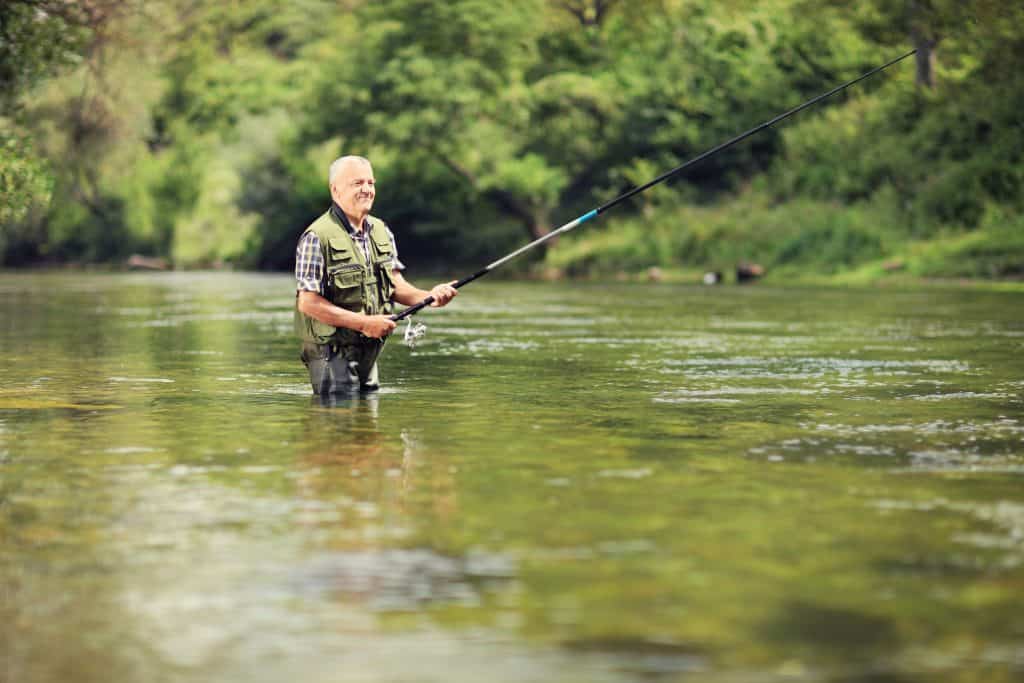
We all know that the water is traveling downstream with the currents. However, what many of us fail to do is truly read how gravity is pulling the water.
Find the path of least resistance (the main flow of the river) and then determine places where the flow may break off onto its own path, or even the places where a new current rejoins the old.
It is in these areas that you are sure to find a fish just waiting to find your line.
#22 Plan Loosely
You can plan the details of your fishing trip from the place you set in, down to the type of sandwich you will eat on your lunch break. However, an important part of fishing is planning for variation.
You can’t set out in the water thinking, “I am only going to use this tactic and am only going to cast into this direction”.
Plan for different weathers, situations, flies, patterns, and even locations!
It is extremely important not to get bogged down on that master plan you created the night or even the week before you arrived at the river.
Unless you can see the future, you never know what unplanned challenges or situations may occur. So, take advantage of the mystery and plan to have your plans changed.
#23 Try Two Flies
One of our favorite places to eat out is the buffet. Why? Because we have LOTS of choices there. Shouldn’t we then offer the fish some choices too?
It might be a little nerve-racking at first, but once you get the hang of it, fishing with two flies might just be what lands you the big one.
Worried that they’ll tangle? A valid fear, but I can honestly say that two flies aren’t going to tangle that much. If you are prepared and have learned the tricks for casting two flies at once, tangles can almost be eliminated. It just takes practice!
So, give the fish more options and your chances of reeling one in might just increase!
#24 Expect the Unexpected
Fish are unpredictable at times and can be quite elusive.
However, one of their greatest hiding spots is in plain sight! You see that part of the river that is just too good to be true, so you avoid it. Or the shallow near the bank that you don’t want to waste your time on.
It’s not a waste of time! Check it out! Oftentimes, the biggest fish are waiting in a place where you least expect to find them.
#25 Flies Can Have Multiple Uses
While we all know that many flies are produced for very specific tasks, we also know we can use them for some unanticipated tasks.
So use your streamers like you would a nymph, or your nymphs as you would a streamer. The point is to try something new!
Fly fishing is not a perfect science where every cast has to be done to a precise measurement. It is important to be creative and to fish according to your situation.
Think outside the box!
#26 Build In Some Bouyancy
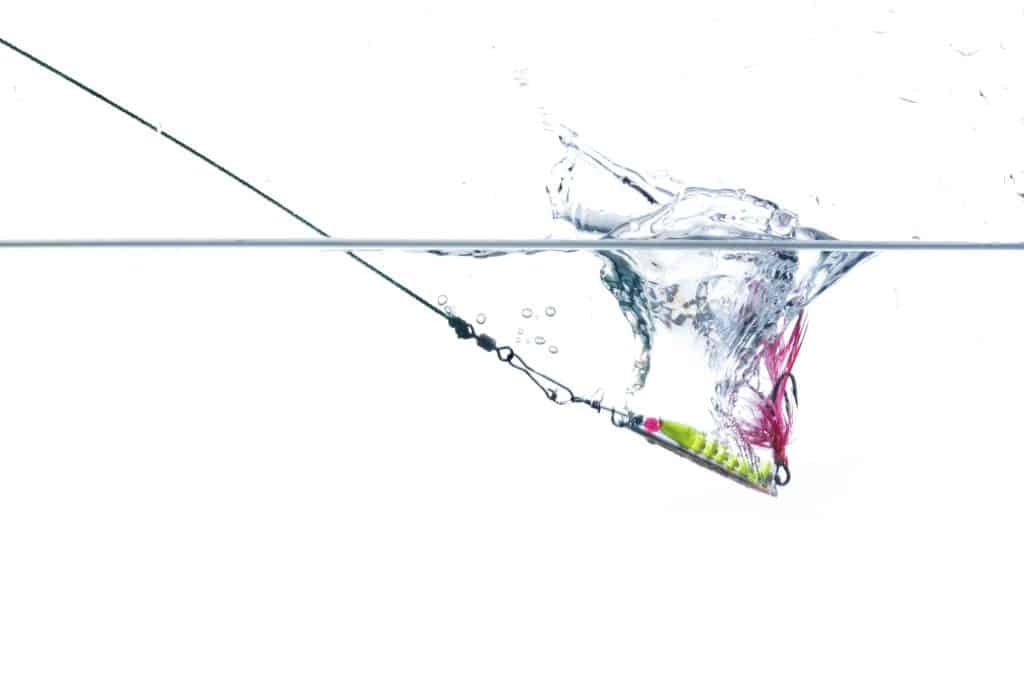
We should always be working hard to ensure our gear maintains its original condition and doing so might take a little extra effort than just being careful.
Waterproofing your dry flies is a great way to help preserve the current status of your flies. There are three different options for how to waterproof: paste, gel, and powder.
If you have a large or bushy fly, opt for paste. This treatment is thicker and therefore works better with larger flies. Since the paste option is thicker than the gel or powder, it also means it will last longer!
For CDC flies be sure not to use gel or paste! Powder floatants are the best way to maintain your CDC flies and give them a little extra float!
For any other flies, a little gel worked into the fibers can go a long way toward helping you have a successful fishing trip.
#27 Break it Down
You’ve been out on the water for hours, fishing the entire river to no avail. But if you look at the situation differently, you’ll find some new strategies.
Instead of fishing the entire river hoping to find the elusive monster, break it down into sections. Fish this stretch for a few hours, then that pocket, then that current.
Having such a wide view of the river can make you miss the smaller, more important details. Focus on one small piece of the river, learn about it, and then move on from there.
Not only will this help you to learn some tips for your current fishing trip, but the next time you fish that same area you will have a greater knowledge of the river and how the fish react in it.
#28 Don’t Just Focus on the Fly
Too often we see people who are so focused on where the fly lands that they forget about the other components of fly fishing.
The leader, the tippet, and the line are each important pieces that matter in every single cast. So don’t just think, “I want to have my fly land here”, think about where all the pieces are going and where you want them to actually go.
Fly fishing is a challenging activity that requires your focus to be drawn to many different things. Challenge your brain! Think about each aspect of the line and where the water will take it.
There is more to fly fishing than just the fly.
#29 Look Up
As I mentioned earlier, its all about angles. The angles that you put between yourself and the fish. To get the upper hand you want to be below the fish.
So take the advantage, and look upstream. Watch to see where the fish are coming from, where they are going, where they rising to the surface, and then anticipate it!
#30 Fish Upstream
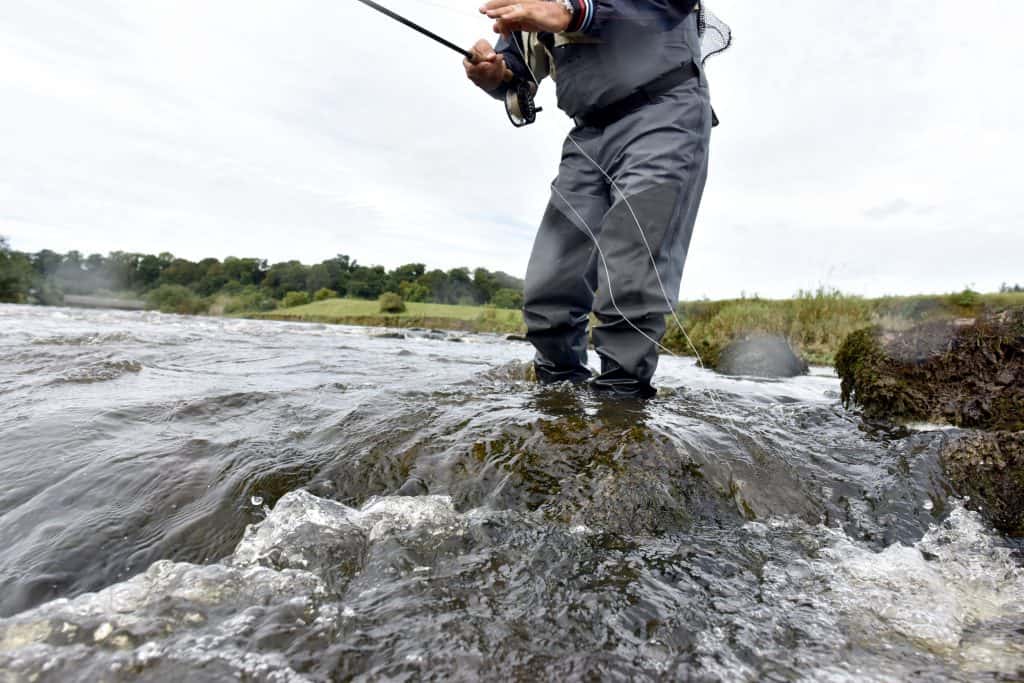
Now that you have anticipated where the fish will be, how the water will carry them and overall what to expect. Cast upstream!
It may feel more natural to fish downstream or even just cast sideways into the river. However, effective fly fishing is all about the angles! Being below the fish gives you the strategic advantage (especially if you follow tip #29).
Want your upstream cast to be even more effective? Try it with a nymph or even a dry fly. I think you will be surprised at the results!
#31 Know the Fish
You just saw the fish rise to the surface. But where is it now?
Your first thought is probably that like everything else in the water, it is traveling with the current. However, a feeding fish is likely to remain in a similar area to the rise (and isn’t usually downstream of it).
The fish you saw rise is probably a few feet or so in front of where it rose, waiting on the next snack to float its way. So cast above the rise and reel ’em in!
#32 Where the Cast Origniates
If you are struggling with your casts and just can’t quite seem to get it where you want it, reassess how you are casting.
Focus on your wrist, and the tip of the rod. Not the entire rod, not just rod, not just the wrist. It’s all about the power you gain in your cast and understanding how the movement of the rod is going to place your line.
Make sure your back cast is completely done before you begin your forward cast or you will not get the full power possible for your cast.
Breathe, slow down, and practice as much as possible. If you are still struggling, try filming yourself and pinpointing exactly where in your cast you are going wrong (this may sound silly but I used this tip all the time in other sports and it is extremely effective!).
#33 Search With Your Dry Fly
Sadly, we don’t get the opportunity to see everything happening above and below the surface of the water.
To help us get a better view or idea of the area around us we can either watch for a long time and try to guess the unknown. Or we can use a dry fly as a sort of “scout.”
Cast it out maybe not with the intention to catch a fish, but rather with the intention to learn what the water is doing. Feel the line and pay attention to each little detail that the fly is communicating back to you.
Use more than just your eyes to try and understand the river, use a dry fly and see all the information you can gain!
#34 Keep Them Above You
I’ve said this before and I’ll say it again. Keep the fish upstream of you.
The advantage is all yours when you are downstream of the fish. If you have to move to keep it that way, do so. Essentially being downstream of the fish is your opportunity to have the fish swim right to you.
Set the hook and direct your prize right to you!
#35 Don’t Get Star Struck
You’re casually casting and have been all day when suddenly, a monster grabs your line and starts to take off.
Now logic would say set the hook and bring them in. Do all you can to keep that monster on your line. However, you may not be hearing logic and may, in fact, be “star struck.”
You’ve caught hundreds of fish in your lifetime, but none like this. Stay calm, remember everything you have learned, and focus on keeping the advantage in your hands.
Hooking a monster can be a rare occurrence. Don’t let the awe of the moment keep you petrified in place as you watch him swim away.
#36 Utilize the Dead Drift
There are so many different patterns and flies you could be using while out on the water, like streamers, wet flies, or hackles. However, if you’re trying to fool a fish, the real way to go about it is with the dead drift.
If you aren’t quite sure how to use a dead drift here are the simple steps:
- Choose where you want your fly to travel (choose the current)
- Cast upstream of your chosen spot
- Mend the line to avoid drag, and even pick up some line off the water
- Wait until the fly is directly below you, let the fly rise
- If no bite, reel it in and try again. If a bite, start the fight!
Use a strike indicator to help you see any subtle bites while dead drifting.
#37 Fishing NOT Catching
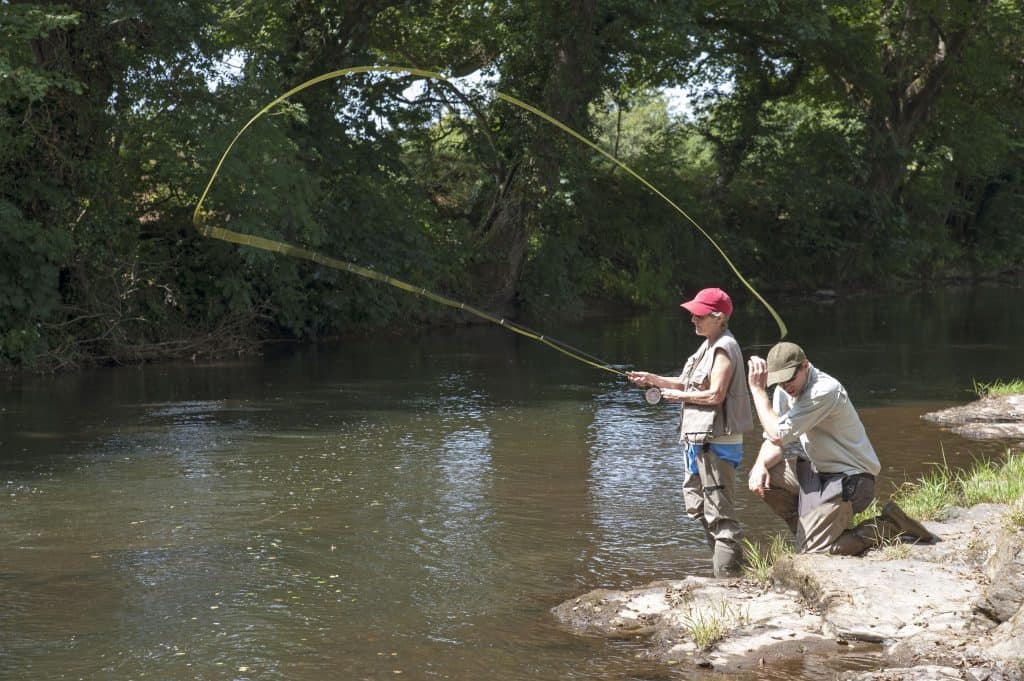
Remember, you are out there to be fishing! Not catching.
While catching the perfect trout definitely brings satisfaction, it is important to not get discouraged simply because you were not as successful as you had hoped.
Fishing is a great way to relieve stress and increase one’s overall well-being and emotions, but only if you are keeping a good attitude!
Don’t ruin the fun of fishing by focusing on the catching (or the lack thereof).
#38 Fish More!
I know it seems like this implied, but as I mentioned at the beginning of this article, practice makes perfect.
You can continue searching other websites, book, and forums but if you don’t go hit the waters the truth is that you will not improve any further than you already have.
#39 It’s Not Too Complicated
I’m sure after reading all of this you may feel a little overwhelmed. But I assure you, fly fishing is not as complicated as it seems.
If you’ve never fly fished before let it be known that plenty of people are self-taught and are still successful fly fishermen.
If you have fly fished and are trying to improve focus on the little details and make them a habit.
No matter what your skill level is currently, start slow and implement one tip at a time. Focus on one piece of the puzzle until you are ready to put the whole thing together!
Take each of the things you’ve learned and start working them into your fishing trips to ensure you will one day become that master fly fisherman you’ve been dreaming of becoming!
And yes, sadly it will take time to achieve this goal, but I promise it will be worth it!
Related Questions
What’s the best fly rod to buy? If you are just beginning to learn how to fly fish, a general use rod will be the best to start with. If you are more experienced and are focusing on a certain tactic look for a rod specialized in that aspect. The biggest thing is, don’t invest big money unless you’re committed.
Where is the best place to go fly fishing? In the United States, there are two places that have earned the nickname of the “Fly Fishing Capital.” These two places are found in the Southwestern rivers of Montana and in the backcountry streams of Pennsylvania.

